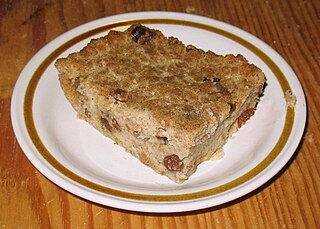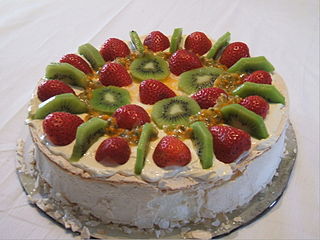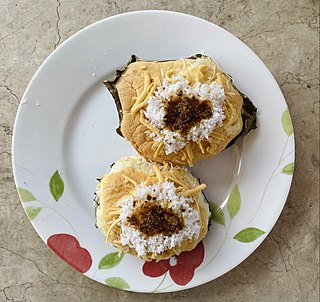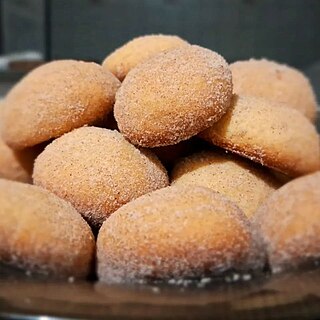
Tigelada or Tigelada de Abrantes [1] is a typical Portuguese dessert made in a wood-fired oven. Its cooking is done in a pre-heated unglazed clay bowl. [2]

Tigelada or Tigelada de Abrantes [1] is a typical Portuguese dessert made in a wood-fired oven. Its cooking is done in a pre-heated unglazed clay bowl. [2]
A Tigelada is in the form of a disk with a thickness of 2 cm (0.79 in) and a diameter of 10 to 12 cm (3.9 to 4.7 in). It presents a yellow-brown color and a sharp texture. Its bottom part is honeycomb due to the high temperature that the bowl reaches in the oven before the mixture is added. Tigeladas are made with eggs, milk, unleavened flour, sugar, lemon and salt. [2]
It has its origin in Lisboa e Vale do Tejo. By consulting the historical archives, the recipe for a sweet called Tigeladas de D.ª Maria de Vilhena was found in the Cookbook of Infanta D.ª Maria, published by the National Press – Casa da Moeda, which coincides with the recipe of Tigeladas de Abrantes. In a more or less consensual way, the product is considered a conventual sweet. There is a set of documentation in the Historical Archive of the Municipality of Abrantes, which contains a list of recipes from the Convento da Graça de Abrantes, which contains the recipe for the Tigeladas. However, its origin is claimed in several locations in the municipality of Abrantes. [2]

Bread pudding is a bread-based dessert popular in many countries' cuisines. It is made with stale bread and milk or cream, generally containing eggs, a form of fat such as oil, butter or suet and, depending on whether the pudding is sweet or savory, a variety of other ingredients. Sweet bread puddings may use sugar, syrup, honey, dried fruit, nuts, as well as spices such as cinnamon, nutmeg, mace, or vanilla. The bread is soaked in the liquids, mixed with the other ingredients, and baked.

Pavlova is a meringue-based dessert. Originating in either Australia or New Zealand in the early 20th century, it was named after the Russian ballerina Anna Pavlova. Taking the form of a cake-like circular block of baked meringue, pavlova has a crisp crust and soft, light inside. The confection is usually topped with fruit and whipped cream. The name is commonly pronounced pav-LOH-və or pahv-LOH-və, and occasionally closer to the name of the dancer, as PAHV-lə-və.

A pancake, also known as hotcake, griddlecake, or flapjack, is a flat cake, often thin and round, prepared from a starch-based batter that may contain eggs, milk, and butter, and then cooked on a hot surface such as a griddle or frying pan. It is a type of batter bread. Archaeological evidence suggests that pancakes were probably eaten in prehistoric societies.

Amaretto is a sweet Italian liqueur originating from the comune (municipality) of Saronno. Depending on the brand, it may be made from apricot kernels, bitter almonds, peach stones, or almonds, all of which are natural sources of the benzaldehyde that provides the almond-like flavour of the liqueur. It generally contains 21 to 28 percent alcohol by volume.

The oldest known book on Portuguese cuisine, entitled Livro de Cozinha da Infanta D. Maria de Portugal, from the 16th century, describes many popular dishes of meat, fish, poultry and others.

Portuguese sweet bread refers to an enriched sweet bread or yeasted cake originating from Portugal. Historically, these sweet breads were generally reserved for festive occasions such as Easter or Pentecost and were typically given as gifts. However, in contemporary times, many varieties are made and consumed year round. Outside of Portugal, Portuguese "sweet bread" translated as "pão doce" is often associated with Azorean "massa sovada" which are similar but traditionally prepared differently.

Abrantes is a municipality in the central Médio Tejo subregion of Portugal. The population as of 2011 was 39,325, in an area of 714.69 square kilometres (275.94 sq mi). The municipality includes several parishes divided by the Tagus River, which runs through the middle of the municipality. The urbanized part, the parish of Abrantes e Alferrarede, located on the north bank of the Tagus, has about 17,000 residents.

The Ribatejo is the most central of the traditional provinces of Portugal, with no coastline or border with Spain. The region is crossed by the Tagus river. The region contains some of the nation's richest agricultural land, and it produces most of the animals used in the Portuguese style of bullfighting.

Torres Novas is a Portuguese municipality in the district of Santarém, in the Médio Tejo of the Oeste e Vale do Tejo region. The population of the municipality was approximately 36,717, in an area that encompasses 270 square kilometres (100 sq mi). The city of Torres Novas proper has about 15,000 inhabitants in an area located within the municipality.

Bibingka is a type of baked rice cake in Filipino cuisine that is cooked in a terracotta oven lined with banana leaves and is usually eaten for breakfast or as merienda, especially during the Christmas season. It is also known as bingka in the Visayas and Mindanao islands.
São João, or São João Baptista, is a former freguesia, located in the municipality of Abrantes, in Santarém District, Portugal. In 2013, the parish merged into the new parish Abrantes e Alferrarede. The population in 2011 was 1,699, in an area of 2.21 km². It was one of the three parishes that make up the urbanized area of the city.
Aldeia do Mato is a former freguesia, located in the municipality of Abrantes, in Santarém District, Portugal. In 2013, the parish merged into the new parish Aldeia do Mato e Souto. The population in 2011 was 441, in an area of 31.68 km².
São Vicente is a former freguesia, located in the municipality of Abrantes, in Santarém District, Portugal. In 2013, the parish merged into the new parish Abrantes e Alferrarede. The population in 2011 was 11,622, in an area of 38.20 km2. It included the northern part of the city of Abrantes.

Quince cheese is a sweet and tart, thick jelly made of the pulp of the quince fruit. It is a common confection in several countries.

Castelo Branco is an inland city and municipality in Central Portugal. It has 34,455 inhabitants in its urban area (2021) and is the seat of the district of the same name. The municipality, with 52,272 inhabitants, is made up of 19 freguesias spread through 1,438.19 km2 (555.29 sq mi), making it the 3rd largest in Portugal by total land area.

The Castle of Abrantes overlooks the city of Abrantes, in the municipality of Abrantes in the district of Santarém, Ribatejo, divided between the two civil parishes of São João and São Vicente. It was part of the Reconquista fortifications that made up the Linha do Tejo, a line of castles and outposts during the Middle Ages, recently integrated into a tourist region called the Região de Turismo dos Templários.

The holiday of Easter is associated with various Easter customs and foodways. Preparing, coloring, and decorating Easter eggs is one such popular tradition. Lamb is eaten in many countries, mirroring the Jewish Passover meal.

Maria do Céu de Oliveira Antunes, previously known as Maria do Céu Albuquerque, is a Portuguese politician who served as the Minister of Agriculture from 2019 to 2024.

Areias are small traditional Portuguese pastries similar to cakes and biscuits. They are commonly coated with coarse-grain sugar, and sometimes cinnamon, which resemble sand for which areias are named after.

Pão de Ló is a Portuguese sponge cake made of eggs, sugar, and wheat flour. Unlike other cakes or breads, yeast or baking powder is generally not used. Rather, to provide volume, air is suspended into the cake batter during mixing.